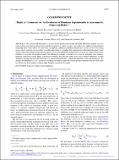Reply to “Comments on ‘An Evaluation of Hurricane Superintensity in Axisymmetric Numerical Models’”
Author(s)
Emanuel, Kerry Andrew; Rousseau-Rizzi, Raphaël
DownloadPublished version (572.3Kb)
Publisher Policy
Publisher Policy
Article is made available in accordance with the publisher's policy and may be subject to US copyright law. Please refer to the publisher's site for terms of use.
Terms of use
Metadata
Show full item recordAbstract
© 2020 American Meteorological Society. For information regarding reuse of this content and general copyright information, consult the AMS Copyright Policy (www.ametsoc.org/PUBSReuseLicenses). We concur with Makarieva et al. that in our earlier work on the hurricane differential Carnot cycle, we neglected the work done in lifting water and the dissipation of kinetic energy in the outflow (we explicitly acknowledged neglecting these terms). Here, we relax those assumptions, affirm the conclusion of Makarieva et al. that the water lifting term is small, and show that the effect of outflow dissipation is negligible. We remind readers that the differential Carnot theory is not a closed theory for potential intensity as it does not specify the outflow temperature or the boundary layer moist enthalpy at the radius of maximum winds. The addition of enthalpy to the inflow can raise the boundary layer enthalpy, reducing subsequent surface fluxes, regardless of whether that addition comes from surface fluxes themselves or from dissipative heating. We show that while this may indeed reduce the effect of dissipative heating, it does not eliminate it. We disagree with Makarieva et al.'s assertions that dissipative heating does not increase potential intensity and that only latent heat fluxes can drive tropical cyclones when dissipative heating is included.
Date issued
2020Department
Lorenz Center (Massachusetts Institute of Technology); Massachusetts Institute of Technology. Department of Earth, Atmospheric, and Planetary SciencesJournal
Journal of the Atmospheric Sciences
Publisher
American Meteorological Society